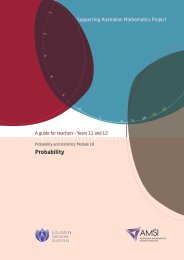Integration - the Australian Mathematical Sciences Institute
Integration - the Australian Mathematical Sciences Institute
Integration - the Australian Mathematical Sciences Institute
Create successful ePaper yourself
Turn your PDF publications into a flip-book with our unique Google optimized e-Paper software.
A guide for teachers – Years 11 and 12 • {21}ProofAs before, let A(c) be <strong>the</strong> area under <strong>the</strong>graph y = f (x) between x = a and x = c.yy = f(x)So we have an area function A(x) whichmeasures <strong>the</strong> area between a and x. Wemust find A(b), <strong>the</strong> area from a to b.A(x)The derivative of <strong>the</strong> area function A(x)is f (x), so A(x) is an antiderivative ofx0 a x bf (x). As both A(x) and F (x) are antiderivativesof f (x), <strong>the</strong>y must differ bya constant, i.e., A(x) = F (x) + K for some constant K . Since A(a) = 0, this impliesF (a) + K = 0. Hence K = −F (a), and it follows that A(x) = F (x) − F (a). Therefore<strong>the</strong> desired integral is equal to A(b) = F (b) − F (a).We can return to our original problem and solve it using <strong>the</strong> fundamental <strong>the</strong>orem.ExampleFind∫ 50(x 2 + 1) d x.SolutionAn antiderivative of x 2 + 1 is 1 3 x3 + x, so we have∫ 50[ ] 1 5(x 2 + 1) d x =3 x3 + x0( 1) ( 1)=3 · 53 + 5 −3 · 03 + 0= 1253 + 5 = 1403 = 46 2 3 .Exercise 10Find∫ 80(3x 2 + 3 x) d x.
















